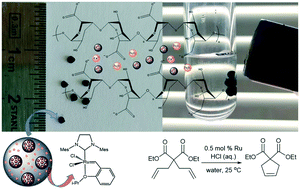Encapsulation of the Hoveyda–Grubbs 2nd generation catalyst in magnetically separable alginate/mesoporous carbon beads for olefin metathesis reactions in water†
Abstract
In this study, nano-sized mesoporous carbon-supported HG2 and magnetic γ-Fe2O3 nanoparticles were encapsulated within calcium alginate gels using a one-pot procedure. Mesoporous carbon within the hydrophilic alginate shell provided hydrophobic compartments for hydrophobic olefinic substrates to conduct olefin metathesis reactions in water under an air atmosphere. Stable alginate/mesoporous carbon gel structures were obtained in the presence of a non-ionic surfactant (Tween20) with a homogenous distribution of HG2 in the gel matrix as confirmed by scanning electron microscopy (SEM) and energy dispersive X-ray (EDX) analysis. The HG2 catalyst encapsulated in the alginate/mesoporous carbon matrix exhibited an improved performance in water, and quantitative yields were obtained in ring-closing metathesis reactions of diethyl diallylmalonate even in tap-water under the air atmosphere with no significant ruthenium and iron leaching. The catalyst can be easily separated from the reaction mixture with the aid of a magnet, and it can be reused up to 7 times in RCM reactions.



 Please wait while we load your content...
Please wait while we load your content...